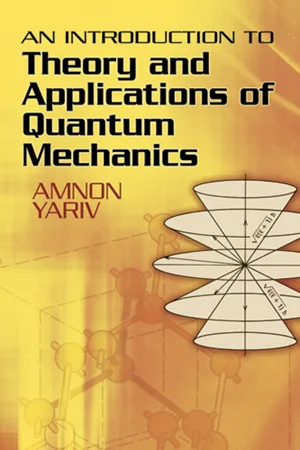
- 320 pages
- English
- ePUB (mobile friendly)
- Available on iOS & Android
An Introduction to Theory and Applications of Quantum Mechanics
About this book
Based on a California Institute of Technology course, this outstanding introduction to formal quantum mechanics is geared toward advanced undergraduates in applied physics. The text addresses not only the basic formalism and related phenomena but also takes students a step further to a consideration of generic and important applications. The treatment's exploration of a wide range of topics culminates in two eminently practical subjects, the semiconductor transistor and the laser. Subjects include operators, Eigenvalue problems, the harmonic oscillator, angular momentum, matrix formulation of quantum mechanics, perturbation theory, the interaction of electromagnetic radiation with atomic systems, and absorption and dispersion of radiation in atomic media.
Additional topics include laser oscillation, quantum statistics, applications of the statistical distribution laws, the interaction of electrons and nuclei with magnetic fields, and charge transport in semiconductors. Each chapter concludes with a set of problems.
Frequently asked questions
- Essential is ideal for learners and professionals who enjoy exploring a wide range of subjects. Access the Essential Library with 800,000+ trusted titles and best-sellers across business, personal growth, and the humanities. Includes unlimited reading time and Standard Read Aloud voice.
- Complete: Perfect for advanced learners and researchers needing full, unrestricted access. Unlock 1.4M+ books across hundreds of subjects, including academic and specialized titles. The Complete Plan also includes advanced features like Premium Read Aloud and Research Assistant.
Please note we cannot support devices running on iOS 13 and Android 7 or earlier. Learn more about using the app.
Information
Mechanics?









Table of contents
- Cover
- Title Page
- Copyright Page
- Preface
- Contents
- Chapter 1 - Why Quantum Mechanics?
- Chapter 2 - Operators
- Chapter 3 - The Basic Postulates of Quantum Mechanics
- Chapter 4 - One-Dimensional Energy Eigenvalue Problems
- Chapter 5 - The Harmonic Oscillator
- Chapter 6 - The Quantum Mechanics of Angular Momentum
- Chapter 7 - Particles in Spherical Symmetric Potential Fields and the Hydrogen Atom
- Chapter 8 - Systems of Identical Particles
- Chapter 9 - Matrix Formulation of Quantum Mechanics
- Chapter 10 - The Time-Dependent Schrödinger Equation
- Chapter 11 - Perturbation Theory
- Chapter 12 - The Interaction of Electromagnetic Radiation with Atomic Systems
- Chapter 13 - Absorption and Dispersion of Radiation in Atomic Media
- Chapter 14 - Laser Oscillation
- Chapter 15 - Quantum Statistics
- Chapter 16 - Some Specific Applications of the Statistical Distribution Laws
- Chapter 17 - The Band Theory of Electrons in Crystals
- Chapter 18 - The Interaction of Electrons and Nuclei with Magnetic Fields. Magnetic Resonance. The Maser
- Chapter 19 - Charge Transport in Semiconductors
- Chapter 20 - The p-n Semiconductor Junction. The p-n-p Junction Transistor.
- Chapter 21 - The Semiconductor Injection Laser
- Bibliography
- Index